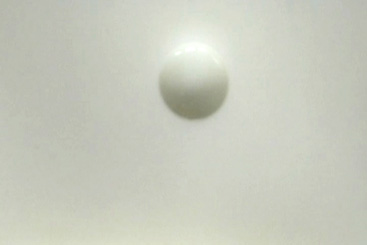
Born in 1960 in Ypres (BE). Lives and works in Tournai (BE)

2004
video colour, no sound
durée : 1'12''
Year of Purchase: 2008
Poetic transposition of a spirit-level, Slow Object 05 (2004) shows the slow-motion travel of an air bubble across a body of milk enclosed in a small, translucent plastic container. The video belongs to the series “Slow Object” begun in 1997, and it reveals the full poetic, minimalist dimension of Edith Dekyndt’s work. Like a mad scientist or a misunderstood genius, the artist invents sensitive measuring instruments whose usefulness is valid for the enchanted world of the displaced everyday. The fabulous dimension, characteristic of the process, is intended to lift the veil on the fantasized reality where inanimate objects come to life, as they did already in Slow Object 01 (1997)—a video showing the ghostly movement of a piece of fabric on top of a chimney of the Chambord castle.
By its sheer presence, Dekyndt’s work incites us to reflect on the paradoxical necessity of fragility in the making of a solid and resistant world. Upon reflection, what could be more tenuous than a spirit-level: an air bubble suspended in a liquid contained in a metal casing that is used in the construction of tall buildings. We surprise ourselves reconsidering the world with infinite freedom, uncovering in every “unstable” thing a potential to accomplish great designs. It would be premature to think that Dekyndt’s work steers its reading and its interpretation toward Zen philosophy which praises scarcity and demonstrates the miracles of nothingness and void—vectors of invisible, ever-present forces acting upon matter. This is only one of the lines of interpretation, but the work welcomes an equally relevant, more down-to-earth, objective, and rational reading. It is interesting to reread Gaston Bachelard on this subject in order to grasp the content of Dekyndt’s work. The philosopher is one of the key thinkers who, from the angle of sciences, examined the artistic spirit that animated him. Bachelard contributed to unconventional areas of knowledge, focusing successively on the study of natural elements (fire, water, air, and earth); he had also witnessed the era of great scientific breakthroughs, including the discovery of electromagnetic waves (Hertz, 1886), X-rays (Roentgen, 1895), radium (Pierre and Marie Curie, 1898), special theory of relativity (Einstein, 1905), atomic disintegration (Rutherford, 1918), and quantum mechanics (Heisneberg, 1924).
Deliberately inviting multiple readings, Dekyndt’s work continues to counter any theoretical reification which would narrow its scope. Rather than put up any traditional resistance, the work slips, contorts and, slithering like a luminous snake, eludes any critical attempts to contain it. An object of temptation, it escapes and enlightens the world. Dekyndt closely examines the real, without adulterating it with artifice, and “ups its scale by a tone” to make possible an “intellectual and affective catharsis” described by Bachelard in the context of science.
Cécilia Bezzan